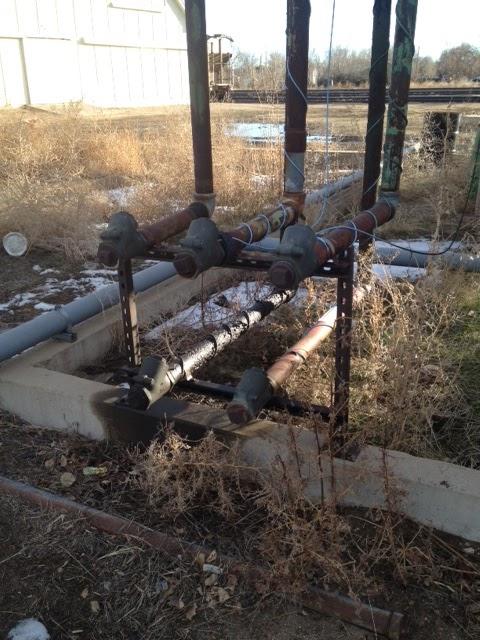AST Operation
Release Detection
Release detection for your aboveground piping is satisfied by your monthly visual inspections. If your AST system includes pressurized underground product piping, your release detection must meet the requirements for UST system piping. UST release detection information can be found on the OPS UST Operation page.
Monthly Inspections
Monthly visual inspections are required for all visible AST system components, including piping if it is aboveground. The tank owner/operator is responsible for conducting these inspections, but the owner/operator can delegate this duty to a person familiar with the fueling system if necessary. An AST Monthly Visual Inspection Checklist should be completed each month. These records need to be maintained for a minimum of 12 months, but are recommended to be kept until the tank system is permanently closed.
Tips for Monthly AST Inspections
- Keep the diked area free of liquid, debris, combustible materials and drums/barrels (whether they are empty or full).
- Any product leakage or seeping connections should be addressed immediately. If product has come in contact with soil or groundwater, the tank owner/operator is required to report a suspected release to the OPS Technical Assistance Line at (303) 318-8547.
- If your AST system has impressed current cathodic protection, the system must be operated and maintained to continuously provide corrosion protection to the metallic components. The impressed current cathodic protection system must be inspected every 60 days to ensure that it is operating correctly; however, OPS recommends that this inspection be completed every 30 days. Rectifier readings will be required for submittal to OPS for the period specified in the Annual Compliance Package.
ASTs that are remote or inaccessible during the winter months
You may not be required to submit monthly visual inspection checklists for the winter months if you meet the following requirements.
- No more than two ASTs are in service at the facility.
- No AST at the facility has a capacity greater than 4,000 gallons.
- ASTs must be secondary containment (double-walled) tanks meeting UL142, UL2080, UL2085 or an equivalent standard. Dike tanks (single-walled tanks with integral diking) do not meet this requirement.
- ASTs must have an automatic interstitial liquid detector with remote monitoring capabilities installed. Results of remote leak detection monitoring during periods of inaccessibility must be documented at least monthly.
- During periods that the site is accessible, the required visual inspection must be conducted on a monthly basis and documented.
ASTs in Vaults
Monthly visual inspections require all sides of the tank to be visible in order to conduct the inspection.
Sometimes, this is not possible through vault openings, so the following alternative methods are available:
ASTs in vaults installed on or before September 30, 1994
- A visual inspection of all portions of the AST and interior of the vault that are visible through vault openings must be conducted on a monthly basis.
- A manned confined space entry must be performed annually to conduct a comprehensive visual inspection of the AST system. This inspection should include tank seams, piping, connections and appurtenances. Requirements for confined space entry can be found in OSHA's 29 CFR 1910. If the vault is equipped with a liquid detection system that activates an alarm in the presence of water or regulated substances, this comprehensive visual inspection can be performed once every two years.
ASTs in vaults installed after September 30, 1994
- A visual inspection of all portions of the AST and interior of the vault that are visible through vault openings must be conducted on a monthly basis.
- A manned confined space entry must be performed annually to conduct a comprehensive visual inspection of the AST system. This inspection should include tank seams, piping, connections and appurtenances. Requirements for confined space entry can be found in OSHA's 29 CFR 1910. If the vault is equipped with a liquid detection system that activates an alarm in the presence of water or regulated substances, this comprehensive visual inspection can be performed once every two years.
Release Detection
If your AST system includes pressurized underground product piping, your release detection must meet the UST Operation Requirements for piping release detection.
Annual Inspections
An annual visual inspection is required for all visible AST system components (including piping if it is aboveground) and is intended to identify leaks and to monitor the condition of tanks, piping, secondary containment and equipment. The annual inspection is more thorough than the monthly visual inspections and is conducted in addition to them.
The tank owner/operator is responsible for conducting this inspection, but the owner/operator can delegate this duty to a person familiar with the fueling system if necessary. The inspection that an OPS inspector conducts at your facility is not a substitute for your annual visual inspection.
An AST Annual Visual Inspection Checklist should be performed within 12 months of the previous annual visual inspection and will be required for the period specified in the Annual Compliance Package.
Tips for Annual AST Inspections
- Maintain a functioning emergency vent. Your annual visual inspection is a good time to make sure the emergency vent is in good working condition. OPS recommends reviewing the American Petroleum Institute's Bulletin 2521 and Recommended Practice 576 for maintenance and inspection procedures.
- If electronic or mechanical tank gauges are used to determine tank liquid levels, the gauge is required to be calibrated on an annual basis or per the manufacturer's instructions. The tank gauge measurement should match manual tank gauge stick readings. These calibrations should be documented and the records should be maintained.
Corrosion Protection Testing
The two common methods of corrosion protection - galvanic anodes and impressed current - must be tested by a qualified cathodic protection tester at least every three years to ensure adequate protection of all tank system components in contact with soil or water. Documentation of passing tests will be required for the period specified in the Annual Compliance Package.
Suction Piping Testing
An AST system with underground suction piping must have a line tightness test conducted at least once every three years. Safe or European suction piping does not require tightness testing if it meets all of the following criteria:
- Operates at less than atmospheric pressure.
- Sloped so that product drains back into the storage tank.
- Includes only one check valve in each suction line that is located directly below and as close as practical to the suction pump.
Formal periodic inspections and testing determine an AST's suitability for continued service. These inspections must be conducted by certified Steel Tank Institute SP001 Certified AST inspectors according to the SP001 standard.
The SP001 inspection must be performed when you're installing a used AST or every 5 to 20 years for existing ASTs depending on the tank capacity, spill control and CRDM (Continuous Release Detection Method).
- Spill control is the means provided to control a catastrophic release and keep it from endangering adjacent structures, properties and waterways. Methods of spill control include diking, impounding and double-walled tanks.
- CRDM is a means of detecting a release of liquid through inherent design. Types of CRDM include double-walled or double-bottom ASTs that can be monitored and release prevention barriers installed under the AST that are compatible with and sufficiently impervious to the liquid being stored. Release prevention barriers must be able to divert leaks to a point where they can be easily detected, such as along the perimeter of the tank. Steel and concrete are common examples of release prevention barriers.
SP001 Inspection Frequency Tank Capacity (gallons) Has Spill Control and CRDM Has Spill Control but no CRDM 660 - 1,100 M; A (no formal periodic inspections) M; A (no formal periodic inspections) 1,101 - 5,000 M; A (no formal periodic inspections) M; A; E(10); L(10) 5,001 - 30,000 M; A; E(20) M; A; E(10); I(20)
or
M; A; E(5); L(10)
30,001 - 39,999 M; A; E(20) M; A; E(5); L(5); I(15) M = Monthly Inspection; A = Annual Inspection; E = External Inspection
L = Leak Test; I = Internal Inspection; (#) = Inspection interval (in years)
Example: E(5) indicates a formal external inspection every 5 years
If an AST is moved/relocated on the same property or from one property to another, it must be first be closed and then reinstalled see our Installation, with all associated notifications.
- For more information about the AST closure process, please visit the OPS Tank Closure page.
- For more information about the AST re-installation process, please visit the OPS Installation, Permitting, and Registration page.

